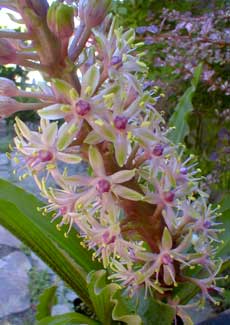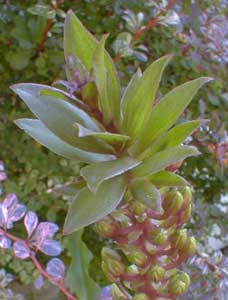
Pink
Pineapple
Lily
Eucomis comosa x pole-evansii 'Pink' is a tender, summer flowering relative of hyacinths, native to rainy mountain slopes of South Africa.
Long lasting flowers begin in August, but the green-budded spikes are already interesting in July. Each deciduous clump produces a number of long-lasting flower spikes. The arching amaryllis-like rosette of serated knife-point foliage is also appealing.
 The green bracts atop the spike of pink blossoms is what gives it the common name Pineapple Lily, as the bracts give the flower the look of an elongated pineapple, especially before the buds under the bracts open & vaguely evoke pineapple scales. Eucomis means "lovely hair" or "beautiful pate," as though the "cap" of spiky bracts was a hairpiece.
The green bracts atop the spike of pink blossoms is what gives it the common name Pineapple Lily, as the bracts give the flower the look of an elongated pineapple, especially before the buds under the bracts open & vaguely evoke pineapple scales. Eucomis means "lovely hair" or "beautiful pate," as though the "cap" of spiky bracts was a hairpiece.For all its tropical looks, Pineapple Lily does well in temperate climates. It can perennialize down to zone seven in moist, humusy, well-draining soil; but it may need winter mulch temperatures regularly fall into the teens. The bulb should be planted more deeply to help keep it from freezing. Or they can be grown in containers & brought in for winter. Soil must drain especially well in winter or rains will cause the bulb to rot.
On Puget Sound where winters are mild, they are very easy clumping perennials. They can tolerate full morning sun in moist well-draining soil, but full afternoon sun may be too much, & if grown further south or inland they need at least a little bit of shade.
In too much shade they will bloom less stunningly, but if attempted in too great a portion of sun, the leaves will wilt between waterings .A momentary drought is all it takes to cause the flower spikes to bend over & rest their bracted heads on the ground, though they will stand back up if water is gotten to them in time.
Although this cultivar's heritage is not entirely certain, it is almost certainly maroon-blossomed E. comosa (formerly E. punctata) crossed with the larger but less colorful (green-flowered) E. pole-evansii.